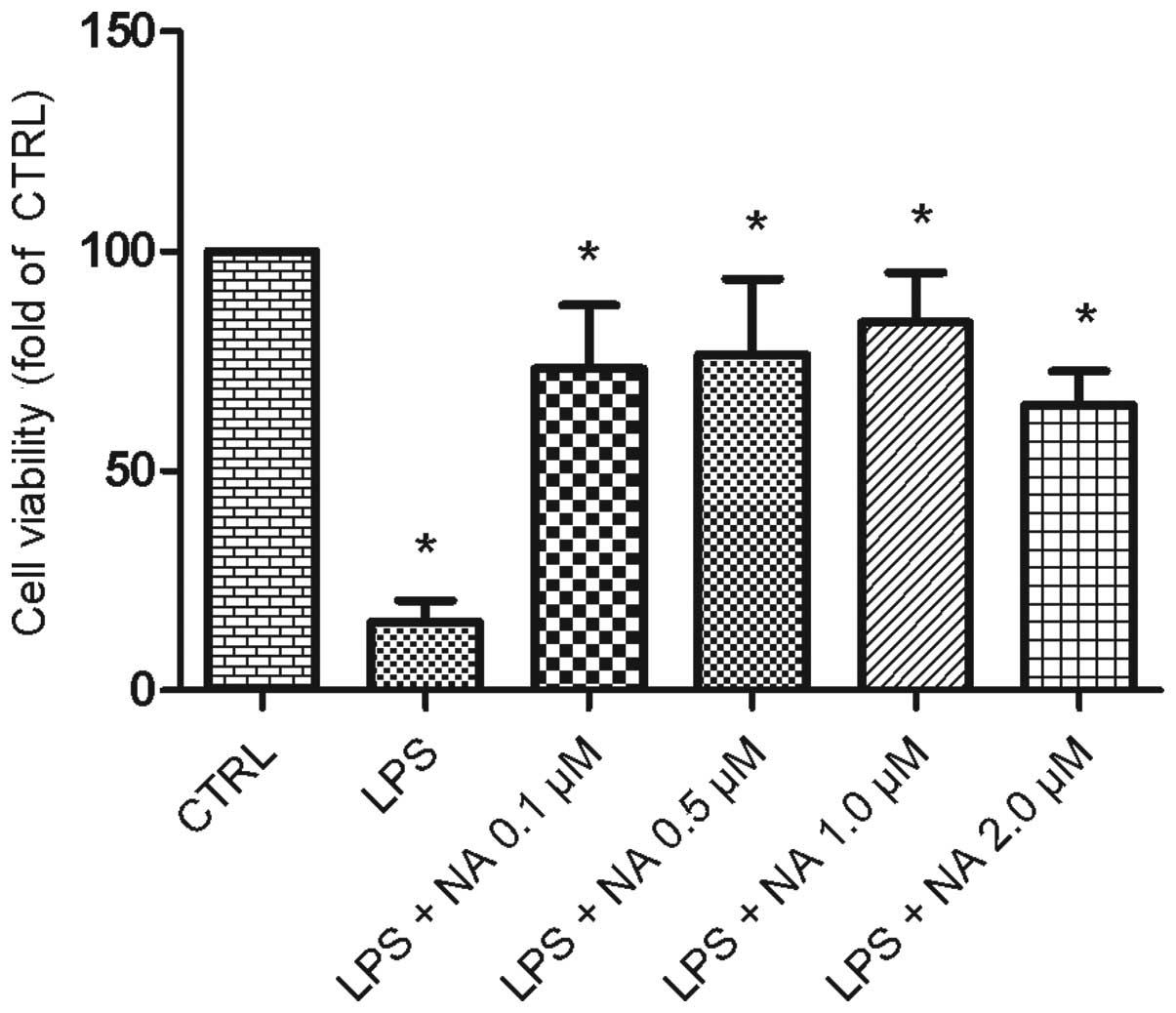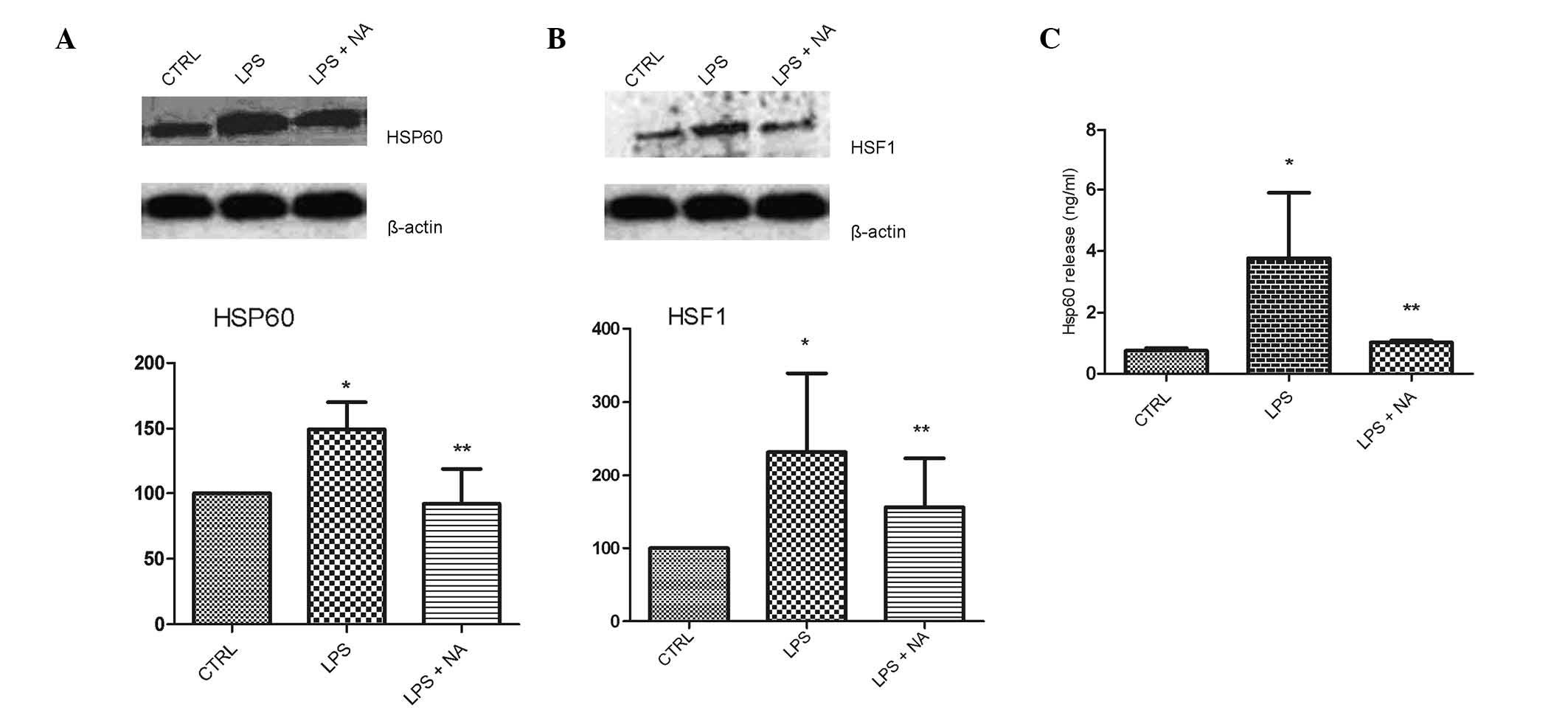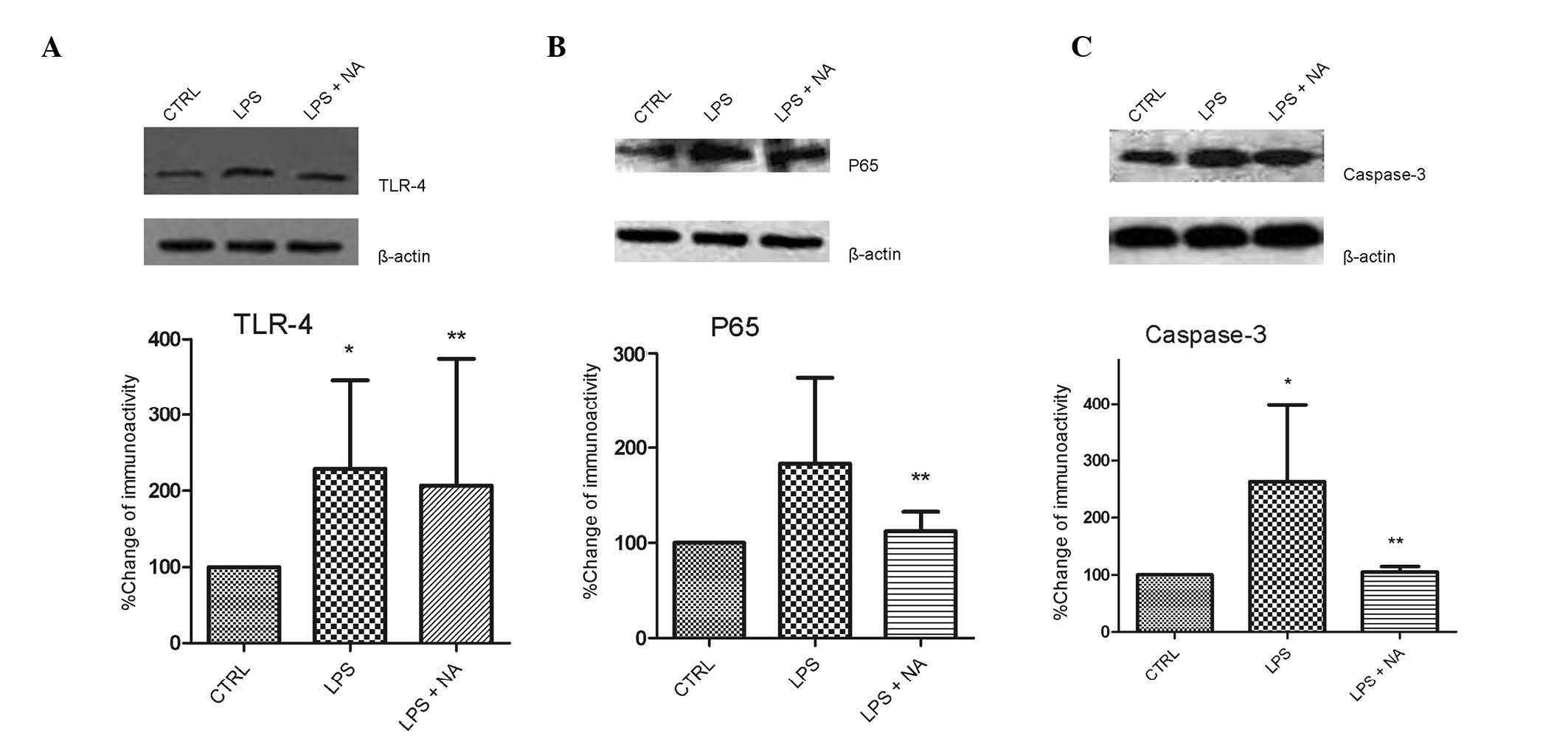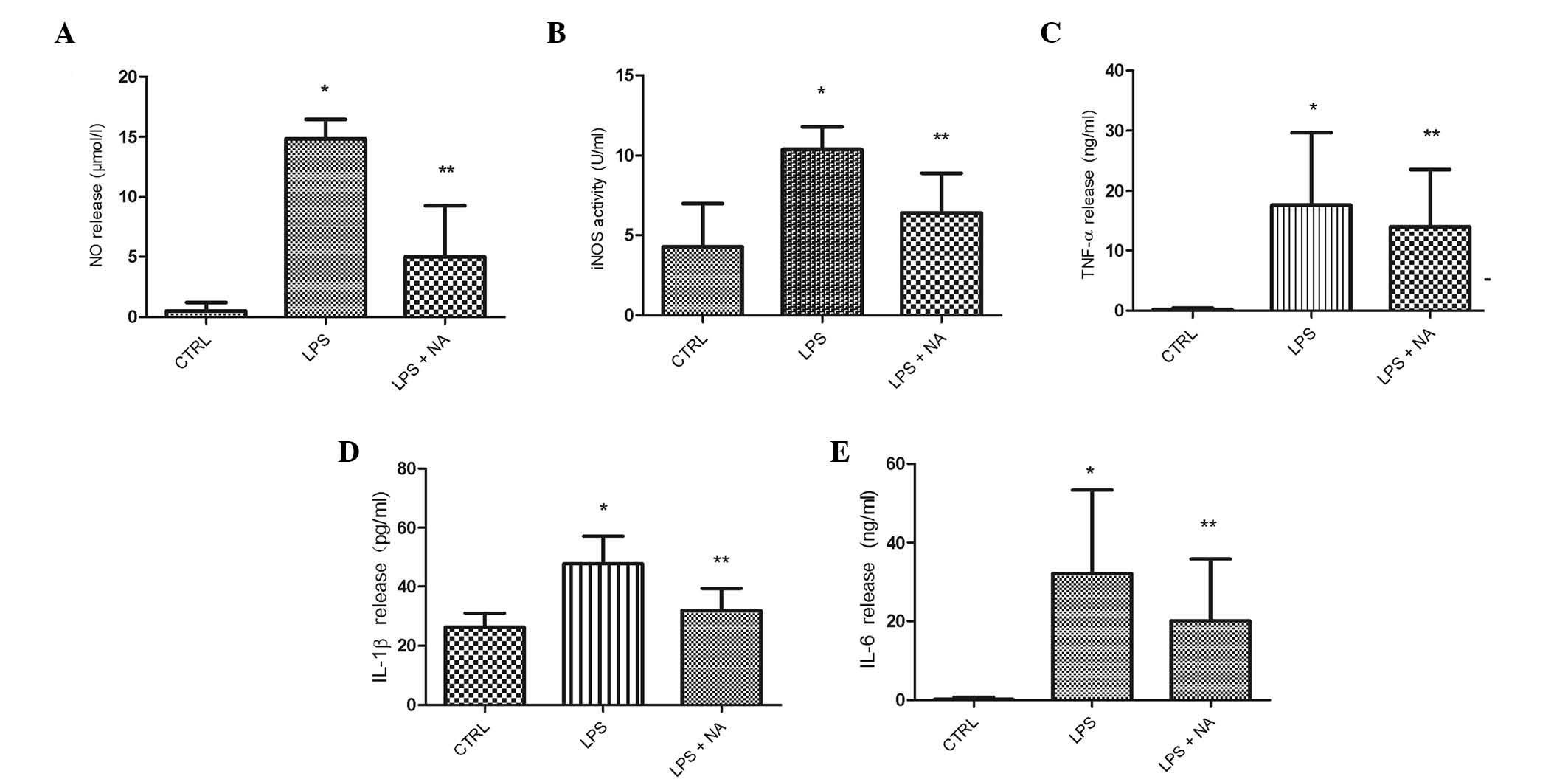HSP60 is involved in the neuroprotective effects of naloxone
- Authors:
- Published online on: July 22, 2014 https://doi.org/10.3892/mmr.2014.2411
- Pages: 2172-2176
Abstract
Introduction
The activation of microglia, the primary immune cells of the central nervous system (CNS), occurs in almost all neurological disorders (1) and is often associated with the increased production of various pro-inflammatory mediators, including nitric oxide (NO), inducible nitric oxide synthase (iNOS), tumor necrosis factor (TNF)-α, interleukin (IL)-1β, nuclear factor-κB (NF-κB), caspase-3 and heat shock protein (HSP)60 (2–6), which all contribute to neurodegeneration (7,8). The importance of microglial activation in neurodegeneration has prompted speculation that the inhibition of microglial activation, in particular the control of neurotoxic factor production, may be an effective therapeutic option for neurodegenerative diseases. Numerous microglia-targeted pharmacotherapies, including protein kinase C inhibitors, microglia inhibiting factor, and various Chinese medicinal herb extracts, have been proposed to inhibit the activation of microglia and to promote neuronal survival in vivo (9–11). However, the inability of these drugs to penetrate the blood-brain barrier, in addition to side-effects that they may produce, limit their long-term use in the clinical setting.
Naloxone is a structural analog of morphine and an effective antagonist of the classic opioid receptors that are widely expressed on cells of the central and peripheral nervous systems (12). Administration of naloxone has been demonstrated to be beneficial in the treatment of experimental models of stroke, myocardial and brain ischemia, brain trauma, spinal cord injuries and septic shock (13–15). Naloxone has been demonstrated to attenuate the degeneration of dopaminergic neurons by inhibition of β-amyloid peptide(1–42)-induced microglial activation and degeneration of cortical and mesencephalic neurons, suggesting that naloxone may have potential therapeutic efficacy for the treatment of Parkinson’s and Alzheimer’s disease (16,17). These studies raise the possibility that naloxone binds to sites other than opioid receptors and exerts activity that does not involve the opioid receptor system. Compared with other microglial inhibitors, naloxone has several advantages, including its ability to penetrate the CNS and that it produces fewer side-effects, presenting a potential novel therapeutic option for neuroprotection.
Although naloxone has been demonstrated to inhibit lipopolysaccharide (LPS)-induced microglial activation in the CNS, the underlying mechanism is not well understood. HSP60 was demonstrated to be released extracellularly in cardiac myocytes during heart failure, and induces apoptosis by binding to Toll-like receptor (TLR)-4 (18,19). The aim of the present study was to examine whether HSP60 is involved in the neuroprotective effects of naloxone in LPS-induced inflammatory injury in BV2 microglia.
Materials and methods
Chemicals
Naloxone and LPS were purchased from Sigma-Aldrich (St. Louis, MO, USA). Antibodies against β-actin, NF-κB and TLR-4 (Abcam, Cambridge, MA, USA), anti-HSP60 and anti-heat shock factor (HSF)1 antibodies (Stressgen, San Diego, CA, USA) and an anti-caspase-3 antibody (Cell Signaling Technology, Inc., Beverly, MA, USA) were acquired. Proteinase inhibitor cocktails were purchased from Merck Chemicals (Whitehouse Station, NJ, USA). IL-6, IL-1β and TNF-α ELISA kits were from eBioscience (eBioscience, CA, USA). Bicinchoninic acid (BCA) and enhanced chemiluminescence (ECL) kits were acquired from Pierce (Rockford, IL, USA). Dulbecco’s modified Eagle’s medium (DMEM) and fetal bovine serum (FBS) came from Gibco (Grand Island, NY, USA). Griess reagent (for identifying NO) and nitric oxide synthase (iNOS) kits were from Jiancheng Bioengineering Institute (Nanjing, China). The Cell Counting Kit-8 (CCK-8) was obtained from Beyotime (Nanjing, China).
Microglial cell culture
BV2 mouse microglia (Cell Bank, Shanghai, China) were cultured in DMEM supplemented with 10% FBS, penicillin (100 U/ml) and streptomycin (100 g/ml). Cultures were maintained at 37°C in a humidified incubator gassed with 95% O2 and 5% CO2. Naloxone was dissolved in phosphate-buffered saline (PBS). Cells were treated with the indicated concentrations of naloxone for 24 h following the administration of LPS (200 ng/ml) for the indicated time period.
Cell viability assay
Cell viability was measured using the CCK-8. Cells (7.5×103 cells in 100 μl culture medium/well) were seeded in 96-well plates. CCK-8 solution (10 μl) was added to each well and the cultures were incubated at 37°C for 90 min. Absorbance at 450 nm was measured using an immunoreader (Bio-Rad, Beijing, China). The results were plotted as the mean ± standard deviation of three separate experiments having four determinations per experiment for each experimental condition. The cell survival ratio was calculated by normalization to control.
Enzyme-linked immunosorbent assay (ELISA)
The levels of IL-6, IL-1β and TNF-α in culture medium were quantified according to the manufacturer’s instructions. Absorbance was determined at 450 nm using a microplate reader (Bio-Rad).
Western blotting
Following treatment, BV2 cells were washed with PBS three times and lysed with radioimmunoprecipitation assay buffer (Sigma-Aldrich). The protein concentration was determined with the BCA kit according to the manufacturer’s instructions. Equal quantities of protein were loaded and run on SDS/polyacrylamide gels and then transferred to a polyvinylidine fluoride membrane. Membranes were blocked with 5% dried milk and incubated with primary antibodies in Tris-buffered saline with Tween 20 overnight at 4°C. After being rinsed in milk-TBST, blots were incubated in the horseradish peroxidase-conjugated secondary antibodies. The target proteins were detected using the ECL kit and X-ray films (Kodak, Shanghai, China).
Statistical analysis
Statistical significance was determined using one-way analysis of variance. P<0.05 was considered to indicate a statistically significant difference. All data are presented as the mean ± standard error of the mean.
Results
Naloxone promotes the viability of BV2 microglia
To determine whether naloxone has an effect on the apoptosis of LPS-stimulated BV2 cells, CCK-8 assay was performed. The results indicated that treatment of microglia with 0.1–2.0 μM naloxone for up to 24 h significantly increased the viability of LPS-stimulated BV2 cells, compared with that of the LPS group (Fig. 1). Naloxone at a concentration of 1.0 μM exhibited the maximal protection, so this concentration was selected for the subsequent experiments. The results indicated that naloxone has a positive effect on the viability of LPS-stimulated BV2 microglia.
Naloxone inhibits HSP60 protein expression and release in LPS-stimulated BV2 microglia
Levels of HSP60 expression and release were measured in activated BV2 cells. Western blot results indicated that LPS induced an increase in the expression levels of HSP60 compared with levels in controls, and that naloxone significantly inhibited this increase (Fig. 2A). The HSP60 promoter has been reported to have a heat shock element that is the binding site for HSF-1, which regulates HSP60 gene expression (20). Therefore, HSF-1 levels were investigated, and demonstrated to exhibit the same expression pattern as that of HSP60, indicating that HSP60 expression is driven by HSF-1 (Fig. 2B). HSP60 has been reported to translocate extracellularly upon stress in order to exert injury effects (11). ELISA results demonstrated that HSP60 was released upon LPS-induced activation of BV2 cells, and this increased extracellular HSP60 may be suppressed by naloxone (Fig. 2C).
Naloxone inhibits TLR-4, NF-κB and caspase-3 expression
TLR-4 mediates inflammatory responses in activated microglia. In the present study, it was demonstrated that TLR-4 expression levels in LPS-stimulated BV2 cells were reduced by naloxone (Fig. 3A). The expression levels of the p65 subunit of NF-κB, which is a pivotal factor in the TLR-4 pathway, increased following LPS stimulation, but this effect was markedly inhibited by the addition of naloxone (Fig. 3B). Caspase-3 is upstream of NF-κB in this signaling pathway, and inhibition of caspase-3 has been demonstrated to prevent neuronal loss in brain diseases involving activated microglia. Thus, in the current study, the effects of naloxone on caspase-3 expression were examined (Fig. 3C). Caspase-3 expression was suppressed in LPS-stimulated BV2 cells following naloxone exposure.
Naloxone inhibits the production of proinflammatory factors
Using ELISA assay, naloxone suppression of the release of proinflammatory factors, including NO, iNOS, TNF-α, IL-1β and IL-6, was investigated in LPS-stimulated BV2 cells. As shown in Fig. 4, 24-h naloxone treatment of LPS-stimulated BV2 cells resulted in significant reductions in the levels of the aforementioned factors in culture media compared those following LPS stimulation alone. These results implied that naloxone effectively suppresses the production of neurotoxic factors in activated microglia.
Discussion
HSP60 is primarily considered to be a mitochondrial protein, but a number of studies have established that HSP60 is also involved in apoptosis. When HSP60 is in the cytosol or mitochondria, it is antiapoptotic and protective. However, when HSP60 is in the plasma membrane or extracellular space, it is associated with apoptosis. Previous studies detected HSP60 expression on the exofacial surface of myocytes, where it was a potential antibody target or innate immune system ligand of TLR-4 (18,19). TLR-4 has been shown to be present in microglia (21), and HSP60 is a ligand for TLR-4 in the immune system (22).
A number of studies have identified neuroprotective effects of naloxone, and it was demonstrated to inhibit LPS-induced microglial activation in the CNS (16,17). However, the mechanisms involved remain unclear. In the present study, it was hypothesized that LPS triggered HSP60 release from microglia, and extracellular HSP60 binds to TLR-4 on the surface of microglia, inducing apoptosis by activating the NF-κB pathway. The results supported these hypotheses. A pretreatment of 1 μM naloxone effectively suppressed the activation of microglia. While LPS stimulation increased the expression and release of HSP60, naloxone significantly suppressed these effects. HSP expression is regulated by HSFs. In the current study, HSF-1 expression levels increased as did those of HSP60 when triggered by LPS and then were inhibited by naloxone. Thus, the inhibitory effect of naloxone on HSP60 may occur through inhibition of its transcription factor HSF-1. The overexpressed HSP60 released extracellularly may act as an innate immune signal to further activate microglia.
TLR-4-mediated microglial activation induced cell death, which is a mechanism by which activated immune cells are eliminated. Kim et al (18) demonstrated that extracellular HSP60 activated TLR-4 by binding to it at a different site to that which LPS binds, leading to cytokine production and cardiac myocytes apoptosis. Release of TNF-α may then lead to further myocyte apoptosis and increased HSP60 expression through activation of NF-κB (23). In the present study, it was demonstrated that TLR-4 may be activated on microglia not only by LPS but also by extracellular HSP60, and that activated TLR-4 was effectively inhibited by naloxone. LPS and HSP60 binding to TLR-4 may trigger a cascade of signaling events resulting in the activation of downstream effector molecules such as NF-κB and caspase 3 and culminating in the production of proimflammatory immune mediators, including TNF-α, IL-1β, IL-6 and IL-8. Release of NO and chemokines by these cells has also been reported (24). NF-κB is the major transcription factor in the induction of the transcription of pro-inflammatory genes. The activation of NF-κB has been demonstrated to lead to ischemia-induced neuronal injury (25). Caspase-3 is crucial for apoptosis and CNS inflammation (26) and when caspase-3/7 is blocked, activated microglia are non-toxic to neighboring neurons (27). Activation of the NF-κB-p65 cascade induces HSP60 production and release following oxidative stress (19) possibly by the binding of NF-κB to the HSP60 gene promoter (23). TNF-α is also a mediator of NF-κB signaling and drives the increased expression of HSP60, which can be reversed by p65 inhibition (23). Levels of HSP60, NF-κB and TNF-α are simultaneously decreased by naloxone. By demonstrating the marked inhibition of the expression of caspase-3 and the NF-κB downstream mediator p65, and production of NO, iNOS, TNF-α, IL-1β and IL-6 by naloxone treatment, the findings of the present study suggest that the neuroprotective and anti-inflammatory effects of naloxone may be due to inhibition of the HSP60-TLR-4-NF-κB pathway.
In summary, to the best of our knowledge, the results of the present study indicated for the first time that naloxone may exert its neuroprotective action through HSP60-TLR-4-NF-κB inhibition to prevent the overactivation of microglia.
Acknowledgements
This study was supported by grants from the National Natural Science Foundation of China (grant nos. 31060140, 31260243, 81060034, 81060126 and 81060112); The Project Sponsored by the SRF for ROCS, State Education Ministry (SEM); The Program for New Century Excellent Talents in University, SEM for Professor Yin Wang; and the Grant of 2012 from Ningxia Medical University for Mr Yunhong Li.
References
|
Block ML, Zecca L and Hong JS: Microglia-mediated neurotoxicity: uncovering the molecular mechanisms. Nat Rev Neurosci. 8:57–69. 2007. View Article : Google Scholar : PubMed/NCBI | |
|
Hanisch UK and Kettenmann H: Microglia: active sensor and versatile effector cells in the normal and pathologic brain. Nat Neurosci. 10:1387–1394. 2007. View Article : Google Scholar : PubMed/NCBI | |
|
Gehrmann J, Matsumoto Y and Kreutzberg GW: Microglia: intrinsic immuneffector cell of the brain. Brain Res Rev. 20:269–287. 1995. View Article : Google Scholar : PubMed/NCBI | |
|
Innamorato NG, Lastres-Becker I and Cuadrado A: Role of microglial redox balance in modulation of neuroinflammation. Curr Opin Neurol. 22:308–314. 2009. View Article : Google Scholar : PubMed/NCBI | |
|
Lynch MA: The multifaceted profile of activated microglia. Mol Neurobiol. 40:139–156. 2009. View Article : Google Scholar : PubMed/NCBI | |
|
Li YH, Teng P, Wang Y, Zhang YM, Ma CJ, Pu J, et al: Expression and regulation of HSP60 in activated microglia cells. J Ningxia Med Coll. 8:712–714. 2011. | |
|
Zhang D, Sun L, Zhu H, Wang L, Wu W, Xie J and Gu J: Microglial LOX-1 reacts with extracellular HSP60 to bridge neuroinflammation and neurotoxicity. Neurochem Int. 61:1021–1035. 2012. View Article : Google Scholar : PubMed/NCBI | |
|
Lehnardt S, Schott E, Trimbuch T, Laubisch D, Krueger C, Wulczyn G, Nitsch R and Werber JR: A vicious cycle involving release of heat shock protein 60 from injured cells and activation of toll-like receptor 4 mediates neurodegeneration in the CNS. J Neurosci. 28:2320–2331. 2008. View Article : Google Scholar : PubMed/NCBI | |
|
Thanos S, Mey J and Wild M: Treatment of the adult retina with microglia-suppressing factors retards axotomy-induced neuronal degradation and enhances axonal regeneration in vivo and in vitro. J Neurosci. 13:455–466. 1993. | |
|
Thanos S: The Relationship of Microglial Cells to Dying Neurons During Natural Neuronal Cell Death and Axotomy-induced Degeneration of the Rat Retina. Eur J Neurosci. 3:1189–1207. 1991. View Article : Google Scholar | |
|
Teng P, Li YH, Cheng W, Zhou L, Shen Y and Wang Y: Neuroprotective effects of Lycium barbarum polysaccharides in lipopolysaccharide-induced BV2 microglial cells. Mol Med Rep. 7:1977–1981. 2013.PubMed/NCBI | |
|
Smith AP and Lee NM: Pharmacology of dynorphin. Annu Rev Pharmacol Toxicol. 28:123–140. 1988. View Article : Google Scholar | |
|
Faden AI and Salzman S: Pharmacological strategies in CNS trauma. Trends Pharmacol Sci. 13:29–35. 1992. View Article : Google Scholar : PubMed/NCBI | |
|
Fallis RJ, Fisher M and Lobo RA: A double blind trial of naloxone in the treatment of stroke. Stroke. 15:627–629. 1984. View Article : Google Scholar : PubMed/NCBI | |
|
Kan MN, Chen YT and Lee AY: Naloxone reversal of ischemic arrhythmia is stereospecific and suggests role of endogenous opioid peptides in ischemic heart disease. Proc Soc Exp Biol Med. 200:518–521. 1992. View Article : Google Scholar | |
|
Liu B, Du L and Hong JS: Naloxone protects rat dopaminergic neurons against inflammatory damage through inhibition of microglia activation and superoxide generation. J Pharmacol Exp Ther. 293:607–617. 2000. | |
|
Liu Y, Qin L, Wilson BC, An L, Hong JS and Liu B: Inhibition by naloxone stereoisomers of β-amyloid peptide (1–42)-induced superoxide production in microglia and degeneration of cortical and mesencephalic neurons. J Pharmacol Exp Ther. 302:1212–1219. 2002. | |
|
Kim SC, Stice JP, Chen L, Jung JS, Gupta S, Wang Y, Baumgarten G, Trial J and Knowlton AA: Extracellular heat shock protein 60, cardiac myocytes, and apoptosis. Circ Res. 105:1186–1195. 2009. View Article : Google Scholar : PubMed/NCBI | |
|
Lin L, Kim SC, Wang Y, Gupta S, et al: HSP60 in heart failure: abnormal distribution and role in cardiac myocyte apoptosis. Am J Physiol Heart Circ Physiol. 293:H2238–H2247. 2007. View Article : Google Scholar : PubMed/NCBI | |
|
Hansen JJ, Bross P, Westergaard M, Nielsen MN, Eiberg H, et al: Genomic structure of human mitochondrial chaperonin genes: HSP60 and HSP10 are localised head to head on chromosome 2 separated by a bidirectional promoter. Hum Genet. 112:71–77. 2003. View Article : Google Scholar | |
|
Aloisi F: Immune function of microglia. Glia. 36:165–179. 2001. View Article : Google Scholar : PubMed/NCBI | |
|
Kol A, Lichtman AH, Finberg RW, Libby P and Kurt-Jones EA: Cutting edge: heat shock protein (HSP) 60 activates the innate immune response: CD14 is an essential receptor for HSP60 activation of mononuclear cells. J Immunol. 164:13–17. 2000. View Article : Google Scholar : PubMed/NCBI | |
|
Wang Y, Chen L, Hagiwara N and Knowlton AA: Regulation of heat shock protein 60 and 72 expression in the failing heart. J Mol Cell Cardiol. 48:360–366. 2010. View Article : Google Scholar : PubMed/NCBI | |
|
Ohashi K, Burkart V, Flohé S and Kolb H: Cutting edge: heat shock protein 60 is a putative endogenous ligand of the toll-like receptor-4 complex. J Immunol. 164:558–561. 2000. View Article : Google Scholar : PubMed/NCBI | |
|
Chen J, Zhou Y, Mueller-Steiner S, Chen LF, Kwon H, Yi S, Mucke L and Gan L: SIRT1 protects against microglia-dependent amyloid-β toxicity through inhibiting NF-κB signaling. J Biol Chem. 280:40364–40374. 2005.PubMed/NCBI | |
|
Soria JA, Arroyo DS, Gaviglio EA, Rodriguez-Galan MC, Wang JM and Iribarren P: Interleukin 4 induces the apoptosis of mouse microglial cells by a caspase-dependent mechanism. Neurobiol Dis. 43:616–624. 2011. View Article : Google Scholar : PubMed/NCBI | |
|
Burguillos MA, Deierborg T, Kavanagh E, Persson A, Hajji N, Garcia-Quintanilla A, Cano J, Brundin P, Englund E, Venero JL and Joseph B: Caspase signalling controls microglia activation and neurotoxicity. Nature. 472:319–324. 2011. View Article : Google Scholar : PubMed/NCBI |













